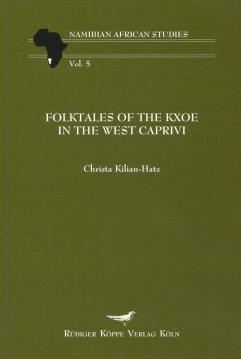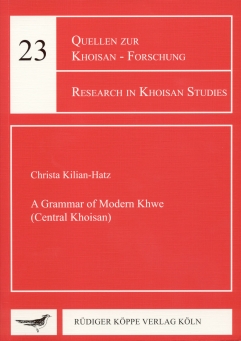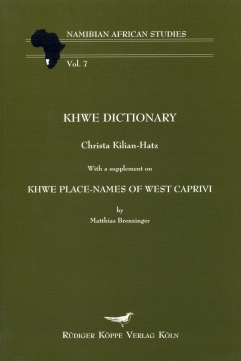




The Kxoe language is classified linguistically as a member of the Central-Khoisan group. The Kxoe live in Northeastern Namibia in the Caprivi strip (with a population of about 8,000), in Angola, Botswana, Zambia, and in Smithsdrift, South Africa, where the Kxoe population numbers approximately 1,600. The collection presented here is the first systematic documentation of Kxoe oral narratives ‘that are not true’.
The Kxoe distinguish between two main kinds of oral narratives: ‘true stories’ and ‘stories that are not true’. ‘True stories’ are didactic in nature and describe, for example, how certain illnesses can be cured. ‘Stories that are not true’ (yiiceregu) do not take place in the present world but in mythical time, and include the three following genres: fables, legends, and creation myths.
The twenty-one yiiceregu in this collection give an overview of the different genres. All yiiceregu are narrated exclusively at night, since it is considered a taboo to tell these stories by daylight; night-time narration is a sign of respect for the ancestors who figure in the stories. To speak about them during the day is to reveal their secrets.
This book is intended to be accessible to all readers interested in oral literature. For ease of readability all twenty-one yiiceregu are presented in the same manner: first the story is told in Kxoe, in numbered sentences that are then rendered in English in an interlinear translation. A free translation in English follows, which remains as faithful as possible to the original narrative, and each English sentence is marked with the number of the corresponding Kxoe sentence. At the end of each narrative, the author provides a short commentary on the moral and messages of the tale.
Under these links you will find publications by the author and further text collections and analyses of oral literature of the Kavango region / Namibia:
Die Publikation der Texte ist vorbildlich: Sie werden sowohl im Original als auch in einer englischen Übersetzung wiedergegeben, jeder tonierte Kxoe-Text ist außerdem mit einer interlinearen Übersetzung versehen. Originaltexte und Übersetzungen sind satzweise numeriert, so daß es leicht möglich ist, die gegebenen Übersetzungen mit den Ursprungstexten zu vergleichen. Um die Phantasie der Leser anzuregen, hat Benat Diwana (ebenfalls Mutc’iku) Illustrationen zu den Geschichten angefertigt, die in die Übersetzungen eingefügt wurden. Jeder Erzählung folgt ein kurzer Kommentar, der die Botschaft oder die Moral des vorangegangenen Textes herausarbeitet. [...]
Diese Sammlung von Kxoe-Texten ist ein weiterer fundierter Beitrag zur Dokumentation oraler Literatur in Afrika. Sie bietet dem Leser die Möglichkeit, nicht nur inhaltliche, sondern auch sprachliche Analysen der Texte vorzunehmen.
Eleonore Adwiraah in Afrika und Übersee, 84/2001, 159-160
Ulrich Braukämper in Fabula, 1/2, 2001, 157-158
© 2026 by Rüdiger Köppe Verlag – www.koeppe.de